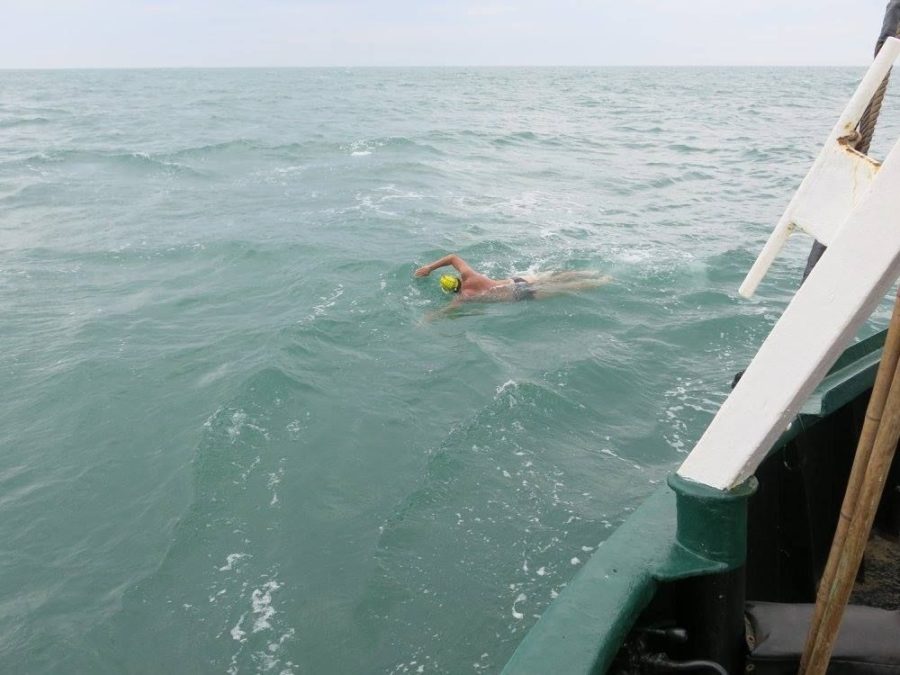ISU student trains to swim in the Baltic Sea
Adam Grimm, senior in horticulture, swims across the English Channel.
October 26, 2017
Adam Grimm, graduate student in history, is preparing for a 300-meter swim in water approximately 30 to 32 degrees Fahrenheit.
If the government and German authorities allow, Grimm is planning on swimming in the Baltic Sea near the German city of Kiel. The swim will potentially take place in the winter or early spring of 2019, largely depending on how long it will take to get permission from the German government.
Grimm is training for this challenge and working toward a master’s degree in European history. Grimm graduated in the spring of 2017 with a Bachelor of Science in horticulture, a Bachelor of Arts in German, a Bachelor of Arts in history and a Russian studies minor.
This swim is not Grimm’s first major undertaking. In July of 2015, Grimm swam 21.7 miles across the English Channel. Although the swim in the Baltic Sea will be much shorter, the temperatures will also be much colder. When Grimm swam the English Channel, the water was 61 degrees Fahrenheit; his swim in the Baltic will likely be in the low 30s.
Since swimming in the Baltic Sea can be dangerous, Grimm must complete the swim in four minutes or less or he could risk hypothermia.
Grimm’s main motivation for tackling the challenge is to deal with his own mental health. Grimm deals with depression and obsessive-compulsive disorder and finds that swimming is a way to turn what he saw for many years as a plague and a curse, into a blessing.
“It’s utilizing both of these two and moving forward in a direction that I can better myself,” Grimm said. “I can help convey to others, and show others- help inspire others to move forward with whatever they have- whatever life has given them.”
Grimm’s training involves doing cold-water acclimations several times a week. Grimm will continue with the acclimations until air and water temperatures drop below 30 to 32 degrees.
Grimm took cold baths and showers for three straight years during his training for the English Channel. After Grimm completed the channel and tried warm water again, he found he preferred cold showers.
To further acclimate to the cold, Grimm wears minimal layers during the winter and keeps apartment temperatures in the 50s if he lives alone. One difficulty Grimm described was not being able to swim indoors because his body will overheat in the warmer water. He also mentioned when classrooms are heated in the winter to 70 degrees, he will sweat because his body is conditioned to the cold.
Apart from temperature acclimations, Grimm lifts weights and does judo on campus.
Grimm has also been swimming his whole life. When he was young his dad worked at the local YMCA, and he would often spend time with Grimm and his six siblings there. Grimm started with water dunks before he was a year old. By the time he was three, he could swim 25 yards unassisted. When Grimm was four, he began competing with other kids.
Grimm swam competitively in high school until he was a junior. When he was 19, he began to regret giving up high school swimming, and after a personal incident at the age of 27, Grimm made the decision to focus on bettering himself rather than altering his life for those around him. Not long after, Grimm was swimming again.
“Along with my goal of swimming in various locations, I want to be able to see the world, in particular, both Germany and Russia,” Grimm said. “Most of the swims I’m hoping to do, barring I’m allowed to do them, will be in and around both of those two countries.”
Another reason was to help him decide if he wants to do a three-mile swim in the Bering Strait, which lies between Alaska and Russia. If Grimm decides to pursue the strait and he gets permission, the swim would take place approximately four years from now.
Another location Grimm hopes to swim someday, contingent upon getting approval, is the Neva River in St. Petersburg, Russia. As a 7 to 10-year goal, Grimm would like to swim the entirety of the Rhine River downstream. This would be a marathon swim requiring over 750 miles. It would take no longer than 50 days.
Getting permission from authorities is a lengthy process taking at least a year, possibly two. Grimm’s swim in the Baltic could be pushed back to 2020 depending on how fast the authorities give permission, if at all.
Some swimming role-models Grimm has used to chart his own course are Lynne Cox and Wim Hof, also known as “The Iceman,” who holds 21 Guinness World Records.
Although Grimm is not following either of them exactly, he’s using their stories to create his own. Grimm hopes his story will inspire others going through similar challenges and someday hopes to do motivational speaking.
Grimm’s advice for achieving goals is knowing this: “The very challenges that you have in life are the very things that can help you succeed.”







